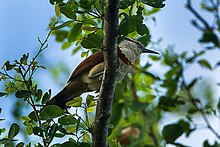
The rufous-breasted wren is a small songbird of the family Troglodytidae. It is found in Colombia, Costa Rica, Panama, Trinidad and Tobago, and Venezuela.

The rufous-backed wren is a songbird of the family Troglodytidae. It is a resident breeding species from southwest Mexico to northwestern Costa Rica.

The berylline hummingbird is a species of hummingbird in the "emeralds", tribe Trochilini of subfamily Trochilinae. It is found in El Salvador, Guatemala, Honduras, Mexico, and the United States.

The white-bellied emerald is a species of hummingbird in the "emeralds", tribe Trochilini of subfamily Trochilinae. It is found in Belize, Guatemala, Honduras, Mexico, and Nicaragua.

The blue-tailed hummingbird is a species of hummingbird in the "emeralds", tribe Trochilini of subfamily Trochilinae. It is found in Costa Rica, El Salvador, Guatemala, Honduras, Mexico, and Nicaragua.

The white-headed wren is a species of bird in the family Troglodytidae. It is found in Colombia and Panama.

The bicolored wren is a species of bird in the family Troglodytidae. It is found in Colombia, Venezuela, Guyana, and Brazil.

Boucard's wren is a species of bird in the family Troglodytidae. It is endemic to Mexico.

The Peruvian wren is a species of bird in the family Troglodytidae. It is endemic Peru.

The chestnut-breasted wren is a species of bird in the family Troglodytidae. It is found in Colombia, Ecuador, Peru and Bolivia.

The grey-throated chat is a species of bird in the family Cardinalidae, the cardinals or cardinal grosbeaks. It is found in Belize, Guatemala, and Mexico.

The moustached wren is a species of bird in the family Troglodytidae. It is found in Bolivia, Brazil, and Peru.

The long-billed wren is a species of bird in the family Troglodytidae. It is endemic to Brazil.

The spot-breasted wren is a species of bird in the family Troglodytidae. It is found in Belize, Costa Rica, El Salvador, Guatemala, Honduras, Mexico, and Nicaragua.

The whiskered wren is a species of bird in the family Troglodytidae. It is found in Colombia, Ecuador, and Venezuela.

The speckle-breasted wren is a species of bird in the family Troglodytidae. It is found in Colombia, Ecuador, and Peru.

The rufous-browed wren is a species of bird in the family Troglodytidae. It is found in Central America from Mexico south into Nicaragua.

The tepui wren is a species of bird in the family Troglodytidae. It is found in Brazil, Guyana, and Venezuela, where it inhabits high tablelands called tepuis.

Sclater's wren is a songbird of the family Troglodytidae. It is endemic to Mexico.

The Veracruz wren is a songbird of the family Troglodytidae. It is endemic to Mexico.






















